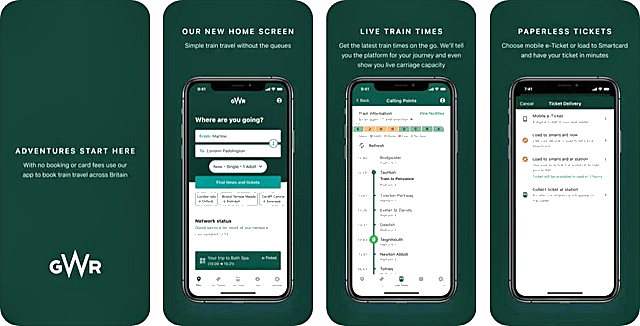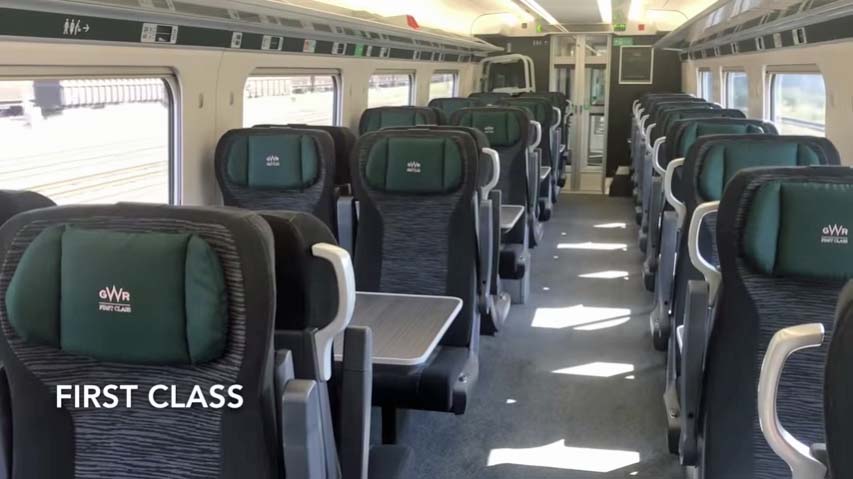this page

First Group Plc. (Link fails 17 Sep 2024)
Modernizing the Great Western Route
With the Android or Apple Great Western Railway smartphone application on your phone you may:- Purchase and download tickets to your phone;
- Add your tickets to Apple Wallet or Google Wallet;
- Load your ticket direct to a GWR smartcard using your phone;
- Purchase Weekly, Monthly, Annual, and Flexi Season tickets;
- Make changes to your booked journeys;
- Request a refund on your unused tickets;
- Make a claim for Delay Repay if you are delayed by 15 minutes or more;
- Check live train running information including carriage capacity (where available).

Andy Roden.
2010.
Aurum Press.
Hardcover.
306 pages, 12.7 x 20.3 cm, £53.12 (Amazon)
The Great Western Railway (GWR) was God's Wonderful Railway if you were a fan, or Great Way Round for those with a more jaundiced view of the company's sometimes circuitous routes. Either way, 175 years after its foundation, the GWR is remembered with more nostalgia and love than any of Britain's other railways. It built and operated the wonderful mainline from London to the West Country and Cornwall (part of today's First Great Western franchise), and it was engineered by the legendary Isambard Kingdom Brunel, who designed wonders such as Box Tunnel and the Royal Albert Bridge. Its steam locomotives were designed by great men like Gooch, Churchward, and Collett, but the engines were only half the appeal, the grand railway cathedrals of London Paddington and Bristol Temple Meads enhanced the spectacle, as did those innumerable idyllic country halts with little more than a pagoda shelter and a couple of milk churns awaiting collection. The company's engines were painted deep green, its carriages chocolate and cream, and trains like the famous Cornish Riviera became the stuff of legend. Andrew Roden has written the first comprehensive history of this iconic company for more than 20 years, bringing to life the thrilling and often surprising story of the Great Western Railway, and explaining why all of us railway buffs, or not, owe it a gigantic debt.

E. Wallis.
2014.
Amberley Publishing.
Paperback.
100 pages, 21.6 x 27.4 cm, £13.54 (Amazon)
The E. Wallis photographic archive consists of over 1,000 mostly unpublished images of railways taken between 1924-1934, which show scenes mainly from the Southern or GWR regions. Following on from the success of the first Southern book in the series, Noodle Books are delighted to present the best of the GWR selection, covering locations main and branch, stations, signals, and infrastructure. It is quite deliberate that very few trains feature. The views have to be seen to be believed, and are of remarkable clarity and detail and portray that most iconic of railways, the Great Western Railway, as it has rarely been seen before.

Michael Clutterbuck.
2016.
Heddon Publishing.
Paperback.
176 pages, £7.99 (Amazon)
Dating back to the early 20th century, "Steaming into the Heyday" introduces George Denton, a boy with a dream to follow in his GWR driver's footsteps. Each story takes us to the next station on George's journey, offering a snapshot of life in Britain around and between the two World Wars whilst also offering a fascinating insight into the world of British railways. The characters bring the tales to life, and fans of the "Steaming Into" series will be delighted as this chance to discover how George Denton's career began.

Tony Atkins.
2016.
Noodle Books.
Hardcover.
224 pages, 30.4 x 22.5 cm, £27.50 (Amazon)
Great Western Goods Train Working is a truly remarkable book providing, for the first time, a comprehensive guide as to how that most important of commodities were handled, marshalled, and moved by rail from despatch to destination. Railways including the Great Western were founded upon the basis of goods movement, passengers would come later, which goes to explain why in terms of hierarchy the GWR Goods Manager was for many years senior even to the Chief Mechanical Engineer as the Goods Department brought in more revenue. In this all new book rolling stock is depicted for the first time in the context of how it was used, the train formations, and where and how freight services operated. The culmination of several decades of painstaking research, this complex and detailed subject is split into two volumes both rightly deserving a place on the bookshelf of the enthusiast and historian.

Tony Atkins.
2017.
Crecy Publishing.
Hardcover.
160 pages, 22.4 x 28.2 cm, £27.50 (Amazon)
The name of Tony Atkins will need no introduction to followers of the Great Western Railway. In Part 2 of this monumental work on Great Western Goods working, the story is taken forward starting with 20th Century goods train on the GWR working to the various types of special traffic handled. This heavily illustrated volume looks at perishable traffic, flowers, fruit, vegetables, banana workings, as well as livestock, refrigerated, and fish traffic. There are also sections on dangerous goods and exceptional loads, the movement of the latter often requiring considerable planning to avoid structures and other trains from a load which was outside the standard loading gauge. The culmination of several decades of painstaking research this complex and detailed subject is split into two volumes, both rightly deserving a place on the bookshelf of the enthusiast and historian.

David Wragg.
2017.
The History Press.
Hardcover.
251 pages, £22.06 (Amazon)
For many the GWR was synonymous with holidays by the sea in the West Country, but it was built to serve as a fast railway line to London, especially for the merchants and financiers of Bristol. Its operations stretched as far as Merseyside, it provided most services in Wales, and it was the main line to Cardiff, Bristol, Cornwall, and Birmingham. This book, a classic first published in 2006, reveals the equipment, stations, network, shipping and air services, bus operations including Western National, and overall reach and history of the GWR. Forming part of a series, along with The LMS Handbook, The LNER Handbook, and The Southern Railway Handbook, this new edition provides an authoritative and highly detailed reference of information about the GWR.

Allen Jackson.
2017.
Amberley Publishing.
Paperback.
96 pages, 16.5 x 23.4 cm, £12.48 (Amazon)
Perhaps more has been written about the Great Western Railway than any other, and the company is regarded with the most affection. The combination of an unbroken history, engineering icons of the Victorian era, holiday destinations, and a visual appeal in their design work went a long way in keeping the GWR in pole position. The stations and other structures have long enjoyed the admiration of many and are a quintessential ingredient of the GWR recipe for remembrance. Change had always been with us on the railways and none more so than in the twenty-first century, where much of the GWR scene is to be swept away under the wires of electrification. The GWR proposed electrification of the Taunton to Penzance route in the 1930s and would have carried it out if they had the cash, so, eighty years later, this change has an air of inevitability about it. Great Western Railway Stations is a last look at much of the GWR architecture, some of which is listed, and aims to present a lavishly illustrated overview of what remains of the old company.

Amyas Crump.
2018.
Oxford Publishing Co.
Hardcover.
176 pages, 25.6 x 25.8 cm, £19.31 (Amazon)
The architecture of the Great Western Railway is an example of non-standard as much as standard designs. From the towering Gothic majesty of Paddington and Bristol Temple Meads to the almost anonymous wayside halt, the story of its development is told here and now for the first time in colour. Although impossible to feature every change that occurred in 100+ years, author Amyas Crump has taken a representative selections of stations, goods shed, signal boxes, and other fixed structures to provide a unique insight into the developments and changes that occurred, some caused by varying transport needs and others as finance and fashion altered. A must for the bookshelf of every GWR man as well as students of railway history generally.

David Maidment.
2019.
Pen & Sword Transport.
Hardcover.
200 pages, 25.4 x 24.1 cm, £21.00 (Amazon)
Churchward proposed a 5 feet 8 inch wheeled 4-6-0 for mixed traffic duties in 1901 and it was seriously considered in 1905, but it took until 1936 before his successor, Charles Collett, realized the plan by persuading the GWR Board to replace many of the 43XX moguls with modern standard mixed traffic engines that bore a remarkable likeness to the Churchward proposal. David Maidment has written another in his series of "Locomotive Portfolios" for Pen & Sword to coincide with the construction of a new "Grange" at Llangollen from GWR standard parts to fill the gap left by the total withdrawal and scrapping of one of that railway's most popular classes, to their crews at the very least. As well as covering the type's design and construction, the author deals comprehensively with the allocation and operation of the eighty locomotives and in particular has researched their performance and illustrated it with many examples of recorded logs from the 1930s as well as in more recent times. As in previous volumes, the author has added his own personal experiences with the engines and has sourced more than 250 photos, over 40 of which are in colour.

Laurence Waters.
2019.
Pen & Sword Transport.
Hardcover.
184 pages, 22.1 x 28.2 cm, £21.00 (Amazon)
It could be argued that the Great Western Railway or "Gods' Wonderful Railway" was for many years the most famous railway in England. Much of the railway that we see today was the work of probably one of the greatest engineers of his time, Isambard Kingdom Brunel. The company was also served by locomotive engineers such as Gooch, Armstrong, Churchward, Collett, and Hawksworth, who between them produced a series of locomotives that were well designed, elegant, and powerful. Serving many holiday resorts of the south west, with trains such as "The Cornish Riviera Express", the publicity department exploited to great effect that the Great Western was the "Holiday Line". It is probably true to say that in the years before the 2nd World War the company was producing some of the most effective publicity material in England. Using previously unpublished material from the extensive Great Western Trust collection at Didcot Railway Centre, the book illustrates in both black and white and colour many facets that made the Great Western "Great".

Tony Atkins.
2019.
Crecy Publishing.
Paperback.
208 pages, 21.9 x 28.2 cm, £29.95 (Amazon)
The latest book in this acclaimed series exploring how the Great Western Railway (GWR) organized and conducted its freight business moves on from the era when horse drawn transport predominated to the rise of the internal combustion engine. The arrival of reliable and capable vehicles, particularly in the years after the Great War, transformed this aspect of the GWR's activities, though not before experimentation in relation to some aspects of road haulage that nowadays we might cringe over, was conducted, vehicles employed without brakes, mirrors, and windscreen wipers were tried, many of which are illustrated in the pages of this book. Among topics covered are the repair, garaging, and management of motor vehicles, liveries and numbering, cartage agents, country lorry services, railhead distribution, and zonal collection and delivery arrangements. Livestock traffic is also discussed in relation to cattle markets, horse fairs, and agricultural shows. Special cartage facilities, the use of containers and the economics and costs of cartage are also considered. This comprehensive and heavily illustrated volume also includes appendices providing much information on fleet lists and registration numbers, accidents involving GWR vehicles and the use of steam wagons.



